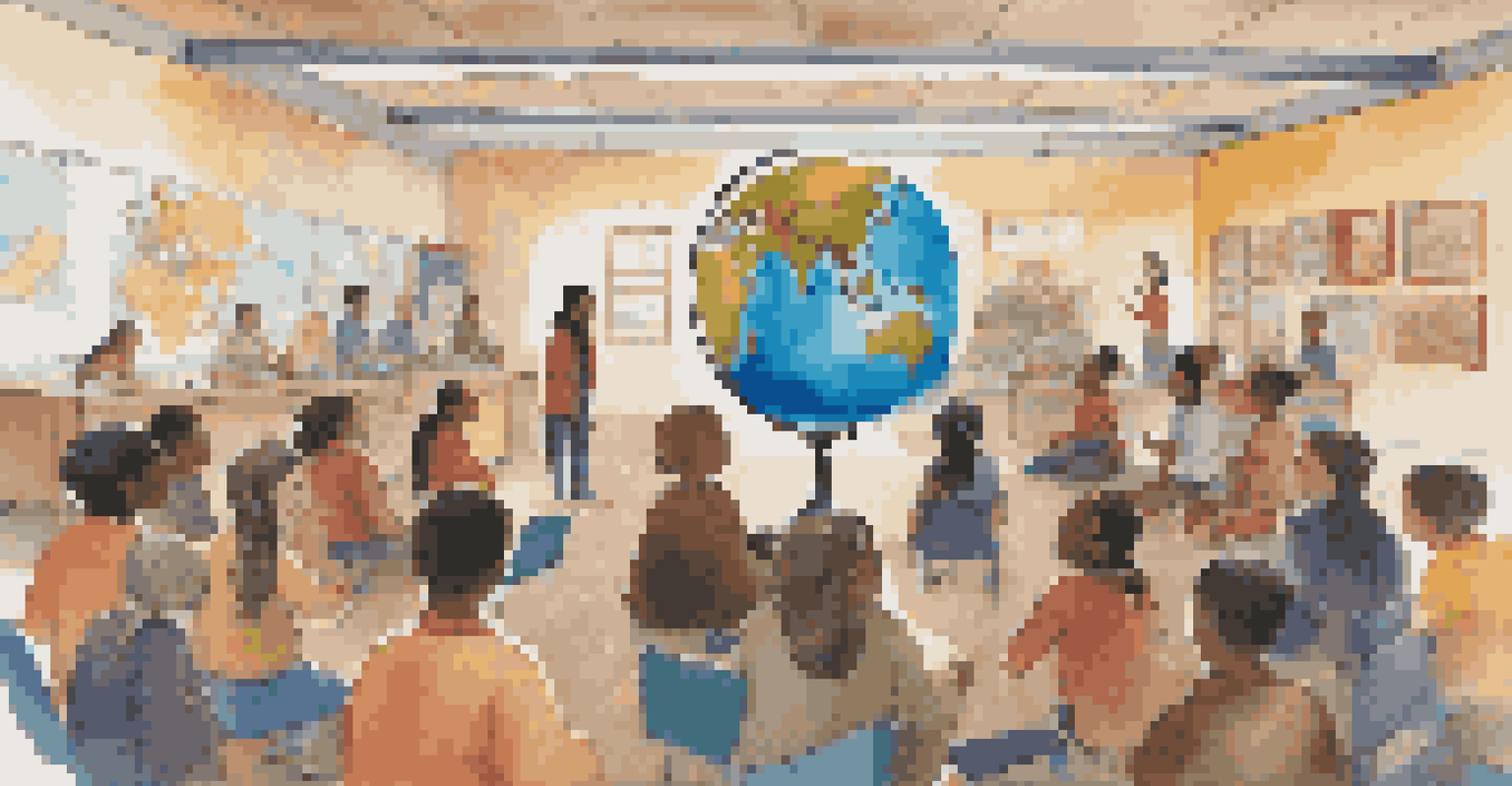Integrating Global Citizenship into Educational Frameworks Today

Understanding Global Citizenship in Education
Global citizenship is an awareness of the interconnectedness of our world. It emphasizes the responsibilities we have not only to our local communities but also to global societies. In education, this concept encourages students to think critically about their roles in addressing global issues.
Education is the most powerful weapon which you can use to change the world.
By fostering a sense of belonging to a larger community, educators can help students develop empathy and understanding for diverse cultures and perspectives. This is crucial in today’s increasingly globalized society. For instance, when students learn about climate change, they recognize that their actions have repercussions beyond their immediate environment.
Integrating global citizenship into curricula can empower students to become active participants in creating positive change. It prepares them for a future that requires collaboration across borders. This integration is not just an add-on; it’s a fundamental shift in how we approach education.
The Role of Educators in Promoting Global Citizenship
Educators play a vital role in shaping students' perceptions of global citizenship. They can create an inclusive classroom environment that encourages dialogue about global issues. By facilitating discussions on topics like poverty, inequality, and environmental sustainability, teachers can inspire students to become more socially aware.

Moreover, educators can serve as role models, demonstrating active citizenship through their own community involvement. When students see their teachers engaged in social causes, it encourages them to participate as well. This hands-on approach not only enhances learning but also cultivates a sense of responsibility.
Global Citizenship Enhances Empathy
Educators can foster global citizenship to help students develop empathy and understanding for diverse cultures and perspectives.
Professional development programs can equip teachers with the tools necessary to integrate global citizenship into their teaching practices. By sharing resources and strategies, educators can learn from one another and develop a comprehensive understanding of global issues, enriching their students’ learning experiences.
Curricular Innovations for Global Citizenship
Incorporating global citizenship into educational frameworks often requires innovative curricular changes. Schools can introduce interdisciplinary projects that connect students with global themes. For example, a project on world history could include research on how historical events impact modern-day conflicts.
Globalization is a phenomenon that brings the world closer together in many ways, but it also brings with it challenges that require a global response.
Technology also plays a significant role in these innovations. Digital tools can connect students with peers around the world, facilitating collaborative projects that promote cross-cultural understanding. Imagine students in one country working alongside their counterparts in another to tackle a shared global challenge.
Additionally, service-learning opportunities can be integrated into the curriculum, allowing students to engage with their communities while also understanding global contexts. This experiential learning approach not only reinforces academic content but also nurtures a sense of global responsibility.
Assessment Methods for Global Citizenship Skills
Assessing students' understanding of global citizenship can be challenging but is essential for measuring progress. Traditional testing methods may not fully capture a student's ability to engage with global issues. Alternative assessment strategies, such as reflective journals or project-based evaluations, can provide deeper insights into their learning.
Schools can also implement peer assessments, where students evaluate each other's contributions to group projects that address global issues. This not only fosters collaboration but also encourages students to reflect on their learning and the impact of their actions.
Innovative Curriculum Boosts Engagement
Integrating global citizenship into curricula through interdisciplinary projects and technology increases student engagement and collaboration.
Furthermore, incorporating self-assessments can empower students to take ownership of their learning journey. By reflecting on their growth in understanding global citizenship, students can identify areas for improvement and set personal goals for their future involvement.
Building Partnerships for Global Citizenship Education
Creating partnerships with local and international organizations can enhance global citizenship education. These collaborations can provide resources, expertise, and opportunities for students to engage with real-world issues. For instance, partnering with NGOs focused on humanitarian work can give students firsthand experience in community service.
Schools can also connect with other educational institutions across the globe to share best practices and resources. This global network can provide diverse perspectives that enrich the learning experience and foster a sense of solidarity among students from different backgrounds.
Additionally, these partnerships can lead to exchange programs that allow students to experience different cultures firsthand. Such experiences can profoundly impact students’ understanding of global citizenship, helping them appreciate the complexities of global interdependence.
The Impact of Global Citizenship on Student Outcomes
Integrating global citizenship into educational frameworks has been shown to positively affect student outcomes. Students who engage with global issues tend to develop stronger critical thinking and problem-solving skills. They are often more empathetic and culturally aware, traits that are essential for success in our interconnected world.
Furthermore, research indicates that students who participate in global citizenship education are more likely to engage in civic activities. They may volunteer or advocate for social justice, demonstrating a commitment to making a difference in their communities and beyond. This proactive approach not only benefits students but also strengthens societal fabric.
Partnerships Enrich Learning Experiences
Creating partnerships with local and international organizations provides students with real-world experiences that enhance their understanding of global issues.
Ultimately, fostering global citizenship in students prepares them for the challenges of the future. As they become informed and active citizens, they contribute positively to society and the planet, promoting sustainable practices and social equity.
Challenges in Integrating Global Citizenship into Education
While the benefits of integrating global citizenship into education are clear, several challenges remain. One significant barrier is the lack of resources and training for educators. Many teachers may feel ill-equipped to tackle complex global issues due to insufficient professional development opportunities.
Additionally, some educational institutions may prioritize standardized testing over broader educational goals, making it difficult to incorporate global citizenship into the curriculum. This focus on test scores can limit the creativity and flexibility needed to address pressing global challenges effectively.

Finally, cultural differences and varying perspectives on global issues can pose challenges in creating a unified approach to global citizenship education. Educators must navigate these complexities carefully to foster inclusivity and respect for diverse viewpoints while promoting a shared commitment to global responsibility.